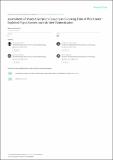| dc.contributor.author | Harouna, Difo Voukang | |
| dc.contributor.author | Venkataramana, Pavithravani | |
| dc.contributor.author | Matemu, Athanasia | |
| dc.contributor.author | Ndakidemi, Patrick | |
| dc.date.accessioned | 2019-10-04T10:18:38Z | |
| dc.date.available | 2019-10-04T10:18:38Z | |
| dc.date.issued | 2019-09-04 | |
| dc.identifier.uri | doi:10.3390/agronomy9090509 | |
| dc.identifier.uri | http://dspace.nm-aist.ac.tz/handle/123456789/449 | |
| dc.description | Research Article published by MDPI, 2019 | en_US |
| dc.description.abstract | Some phenotypic traits from wild legumes are relatively less examined and exploited
towards their domestication and improvement. Cooking time for instance, is one of the most central
factors that direct a consumer’s choice for a food legume. However, such characters, together
with seed water absorption capacity are less examined by scientists, especially in wild legumes.
Therefore, this study explores the cooking time and the water absorption capacity upon soaking
on 84 accessions of wild Vigna legumes and establishes a relationship between their cooking time
and water absorbed during soaking for the very first time. The accessions were grown in two
agro-ecological zones and used in this study. The Mattson cooker apparatus was used to determine
the cooking time of each accession and 24 h soaking was performed to evaluate water absorbed
by each accession. The two-way analysis of variance revealed that there is no interaction between
the water absorption capacity and cooking time of the wild Vigna accessions with their locations
or growing environments. The study revealed that there is no environment × genotype interaction
with respect to cooking time and water absorption capacity as phenotypic traits while genotype
interactions were noted for both traits within location studied. Furthermore, 11 wild genotypes of
Vigna accessions showed no interaction between the cooking time and the water absorption capacity
when tested. However, a strong negative correlation was observed in some of the wild Vigna species
which present phenotypic similarities and clusters with domesticated varieties. The study could also
help to speculate on some candidates for domestication among the wild Vigna species. Such key
preliminary information could be of vital consideration in breeding, improvement, and domestication
of wild Vigna legumes to make them useful for human benefit as far as cooking time is concerned. | en_US |
| dc.language.iso | en | en_US |
| dc.publisher | MDPI | en_US |
| dc.subject | Water absorption | en_US |
| dc.subject | Non-domesticated legumes | en_US |
| dc.subject | Wild food legumes | en_US |
| dc.title | Assessment of Water Absorption Capacity and Cooking Time of Wild Under-Exploited Vigna Species towards their Domestication | en_US |
| dc.type | Article | en_US |

